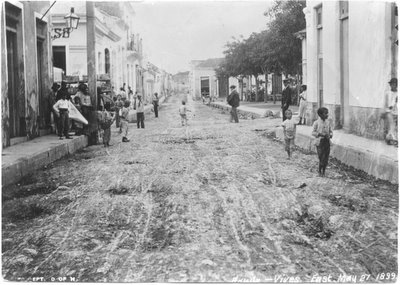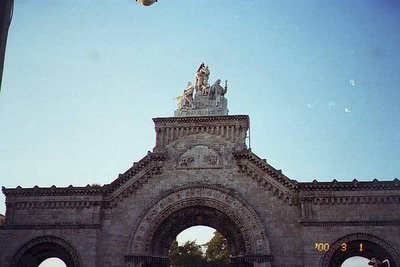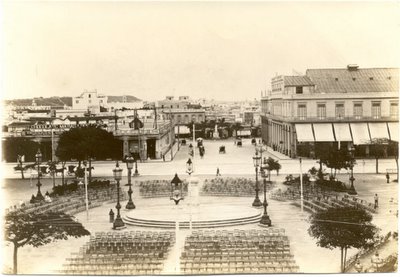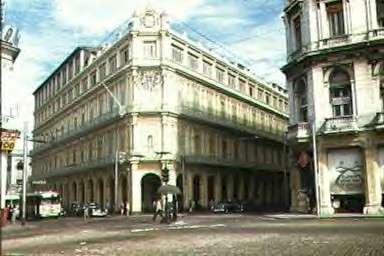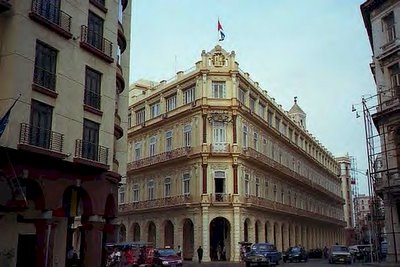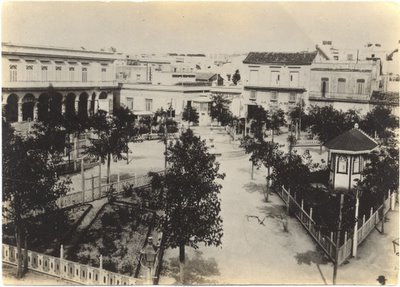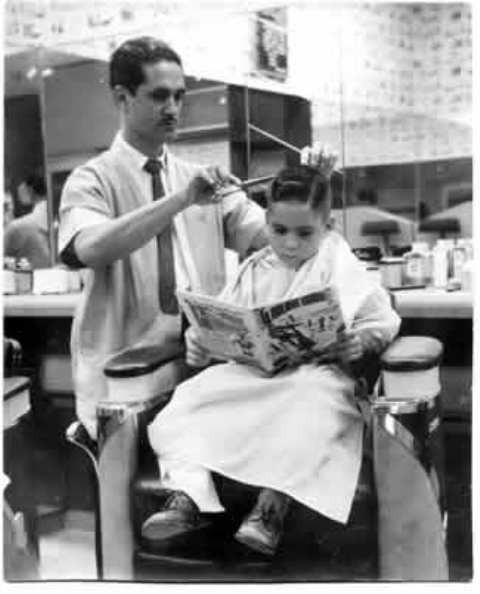"Ajili-Mojili"
Although the title at first may not seem relevant to the prior "Back To The Future - Episode 2" post, it is. I wanted to catch your attention. A friend and follower of this blog commented on my translation of the title for the literary column written by Atanasio Rivero y Azpiri for Diario de la Marina. If you recall, or, if you do not, feel free to revisit Episode 2; the name of the column was "Duelos y Quebrantos." I had translated it as "Duels and Afflictions," but suspected there was something wrong with said translation, even though the official dictionary of the Spanish Royal Academy was consulted. "The correct translation," wrote our friendly critic, is "Mournings and Afflictions." Indeed it is, as Mr. Rivero Sr. was not interested in writing about dueling. His love was Cervantes and Don Quijote or Quixote for our non-Spanish speakers. All this piqued my curiosity, and decided to undertake a mini-Quixotic quest about these things. Your blogger was hoping, among other things, to find somewhere on the web, an image of the column written by Mr. Rivero. Alas, my tilting at this windmill did no good, although a reference to the Centennial issue of Diario de la Marina was found here - and to those of you who know your Cuban/Spanish literary personalities, you will find many listed here, in the index to the articles, including poetry, written by said personalities for the Centennial issue, published in 1932:
It is in Spanish. And if you desire to actually view images of Diario de la Marina, and perhaps find our Ingenious Knight's column, at a price, of course, CD-ROMs of the Diario, spanning the years 1947-1957, can be obtained through the University of Florida, Gainesville. Go here for more information (it is in Spanish) about what is available -
On the home page, look in the left-hand column for a link labeled "Magazines and Periodicals. That will take you to the page with the listings of periodical materials and CD ROMs available. The University of Miami has Diario de La Marina collections spanning the period 1832-1960. This may be a worthwile endeavor-to search these archives-so you can sample Cuban journalism at its best, before it was replaced with rags such as "Granma," which should be renamed the "Havana izvestia-pravda," since it contains neither news nor truth.
I did find a reference to an article he wrote for the Diario on July 17, 1906. It was titled "Comidilla," meaning a person's taste, preferences, or even quirks. Unfortunately, this is all - it was part of a list of literary works, but not a complete article. So, Mr. Rivero was writing for Diario de La Marina right during the early days of the Cuban Republic. Given that dad obviously read his "Duelos y Quebrantos" column, and taking his age into account, but without giving it away...Mr. Rivero must have continued writing into the late 1930's, and even the '40s.
And where does the title of this post figure here, and what does it mean? Well, dad shared a tidbit about "Duelos y Quebrantos," telling not only what the column was about, things having to do with Spanish literature, with an emphasis on Cervantes, but also that Mr. Rivero always ended the column with the expression "Ajili-Mojili!" You may recall prior mention of his interest in Don Quijote and quixotic matters in general. Apparently Mr. Rivero, from what has been gathered by your blogger in researching him, had some interesting opinions, theories, and observations about the writings of Cervantes and evidently with an emphasis on the adventures of Don Quijote - or Don Quixote, as you wish - de La Mancha. In his writings, he seemingly liked to throw in playful, sometimes not so obvious references to the life and adventures of the Ingenious Knight. And hence, "ajili-mojili." Defined by the Spanish Dictionary of the Royal Academy as "a kind of sauce or pebre for stew." And what the windmill is "pebre?" Well, according to our reference, "a sauce which is made of pepper, garlic, parsley, and vinegar, used to season different dishes." So, we - or Don Quixote and Sancho Panza - surely, you know Sancho - have our sauce. And what might that sauce go with? Ah, a staple of Don Quixote's diet, and possibly Cervantes' as well: "Duelos y Quebrantos."
The Royal Academy's academicians describe "duelos y quebrantos" as a "fried mixture of eggs and fatty animal parts." Fried fat and eggs - how's that for spiking up your cholesterol? Perhaps that is why much strong red wine was drunk in those knightly days. You needed something to clean your plumbing after clogging it with "duelos y quebrantos" with a touch of "ajilimojili." And perhaps, if you were reduced to looking forward to such a diet, day in, day out, you might understand why the dish translates to "mournings and afflictions." Nice, ironic description, nice play on words. A very Spanish thing, indeed a very Habanero, very Cuban thing.
And if you wish to explore the Quixotic or Cervantian diet in a bit more detail, and assuming you master the Castilian Tongue, you may want to link up with this interesting article: "Apuntes sobre la alimentacion en la epoca de Cervantes." This to be found in www.grupoaulamedica.com/web/nutricion/nutri22005.cfm - click on the link with the title of the article to open the .pdf file. You will have to cut and paste to your browser so you can go there. Unfortunately, was not able to link directly from the blog site.
These days, in Havana, "duelos y quebrantos," spiced with "ajilimojili" might well be considered a meal fit for an Ingenious Knight, or an Ingenious Cuban, as the case may be. For one must be very ingenious these days, in those latitudes, in order to dodge and stay out of the way - and out of reach - of the windmilling, out-of-control bearded ogre and his grumpy gnomes and trolls. And "resolve" a meal or two in the process..."resolve"...another word which is word play in Havana these days. Meaning "doing whatever it takes and no matter what it takes to live life normally in an abnormal place and time." Wonder if that will make it into the Royal Academy Dictionary? Wonder what Mr. Rivero would have written regarding "resolve" in Diario de La Marina? But he would have had to do it before May 11, 1960...when the windmilling ogre strangled the Diario and buried it forever, there being no Don Quixote to tilt at, and skewer him with, his lance. Mournings and afflictions fulfilled.
Before ending this interlude, we may as well take a look at the work environment within which Mr. Rivero labored - in "Back To The Future - Episode 2" we took a look at some exterior shots of the Diario de La Marina building at the turn of the Twentieth Century.
 This is the library at the Diario, circa 1920. The writers had its considerable resources at their disposal - so they could perform the rigorous, disciplined research a journalist worthy of his or her name would need to undertake in order to write accurately, with relevance and coherence. Wonder if New York Times writers did that, and do, today? I wonder what Mr. Rivero thought of Herbert Matthews' writings, if he got to read them? Or those regurgitated by that Ukrainian-famine denying nut, another New York Times pseudojournalist, Walter Duranty, the Stalin gluteus-osculator of the 1930s?
This is the library at the Diario, circa 1920. The writers had its considerable resources at their disposal - so they could perform the rigorous, disciplined research a journalist worthy of his or her name would need to undertake in order to write accurately, with relevance and coherence. Wonder if New York Times writers did that, and do, today? I wonder what Mr. Rivero thought of Herbert Matthews' writings, if he got to read them? Or those regurgitated by that Ukrainian-famine denying nut, another New York Times pseudojournalist, Walter Duranty, the Stalin gluteus-osculator of the 1930s?By the way, the photo of the Diario library is from www.sapiensman.com - the web site is called "The Old Times."
So we started, at turn of the century - the 20th, that is - Havana, and digressed into Cervantes, Don Quixote, food, Atanasio Rivero, Havana newspapers...is this too manic for you? No, it is meant to show you another aspect of the Havana that was. Don't let anyone tell you it did not produce great writers, great literature, great newspapers, yes, even great electronic - or perhaps we should say electric - media people. One could do books, blogs, web sites on any one of these topics.
Let's just concentrate on Havana newspapers at this point, since the Ingenious Knight and Mr. Rivero have taken us down this path. Diario De La Marina was an important one, but by no means the only major or important one. There was Prensa Libre, there was El Mundo. There was a newspaper like news magazine, heavy on the photographs and printed on semi-gloss paper, which I recall well, as I enjoyed looking at the pictures - "Rotograbado." The title means "rotogravure" or "offset press" publication. Want to see something funny, from one of the Quiroga vault clippings?

I always hated the costume. Sorry, good people from Galicia, Spain, as it is a regional outfit, from Galicia. I wanted to wear a cowboy or army outfit, like my friend Hugo in the photograph. But, hey, we made the pages of Rotograbado! This was published around February 1957, during carnival time. Anybody out there remember the Comodoro Yacht Club? We were members. That was a nice place, except now only foreign "tourists" can go there. Hugo and Alina Ayala: Wherever you are, if you see this, a hearty hello! And a "Cuban Hug." They were our neighbors/playmates at Focsa. As with us, their parents did not stick around to find out what lovely surprises the bearded weirdo had in store for them.
And then there was my favorite publication, a weekly satirical paper, featuring many famous, at the time, satirical writers and caricaturists, whom no doubt many Habaneros from "those days" remember fondly - Prohias, Silvio, Arroyito, Fresquito Fresquet. Surely, you remember "Zig Zag." I recall the vendors, when the new issues were out, hawking it, shouting "Vaya el Zi' Za'!" - "here's Zig Zag," or "there goes Zig Zag!" You could buy this, the Mad Magazine of Havana, from the newsboys or at the newstands, such as Mr. Pando's at the Focsa building, "Vidriera N," or "Countertop N," here advertised in the Focsa's own in-house publication, "Algo" Magazine, from July 1958 -
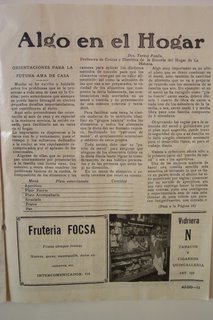
Of course, weirdo-beardo, being humorless and thin-skinned, did not like Zig Zag. So, one of the first publications to be stomped on by "it" and "its" minions, was Zig Zag, this unfortunate event taking place around July 1959. That should have been a wake-up call for Habaneros - he who is humorless must be up to no good...
And here is an image of Zig Zag, not from those days, but from later and better days, when it rose again, phoenix-like, in exile - the front page format is very much, if not identical, to that of the pre-weirdo-beardo Zig Zag - this from the collection of Cuban exile newspapers at the University of Miami, originally published February 16, 1963. Take a look here if you want to explore Cuban periodicals in exile; you will even get to see the front page of Diario de La Marina in exile, the issue of October 8, 1960:

So, in the unlikely event someone shows you this image, weirdo-beardo...IN YOUR FACE! And "happy" Saint Valentine's 2006 to you, too. Maybe you will get flowers - heh,heh.
Back to "Ajili-Mojili!" or "ajilimojili," whatever works for you. In researching this topic, I even found an "Ajilimojili" restaurant in San Juan, Puerto Rico. Apparently quite a popular joint. It is in the Condado neighborhood. Perhaps if you visit it someday, you may think of toasting the memory of Mr. Rivero, Diario de La Marina, Cervantes, Don Quixote, Havana, Zig Zag, Prensa Libre, Rotograbado, El Mundo, and so on, ad infinitum. If you do, clink your goblets, mugs, or glasses and give a hearty "AJILIMOJILI!" in their honor. Shoot, you can do this in your favorite restaurant - outside Havana, that is.
I get the feeling that, somewhere out there, the Ingenioso Hidalgo Atanasio Rivero y Azpiri would be amused - if not quite pleased - with all this...
Ajilimojili!
